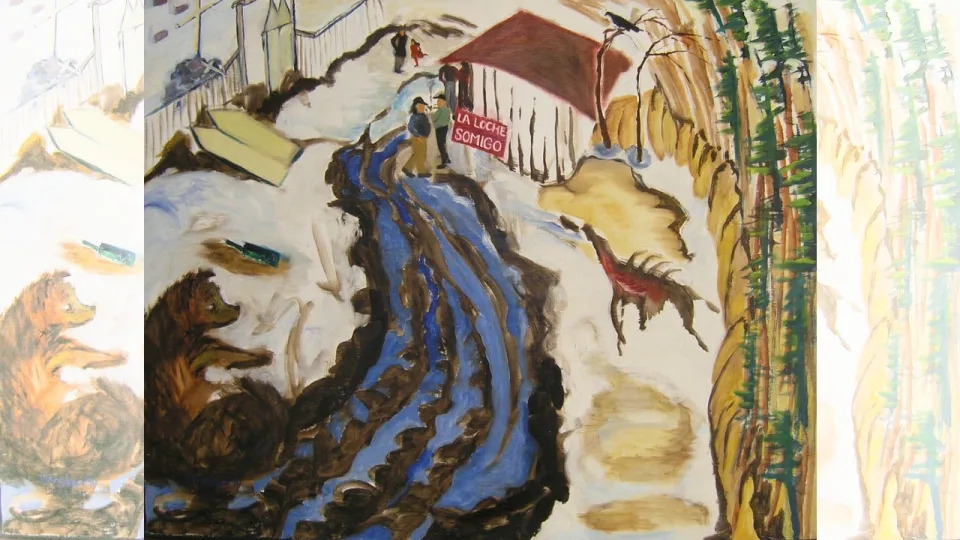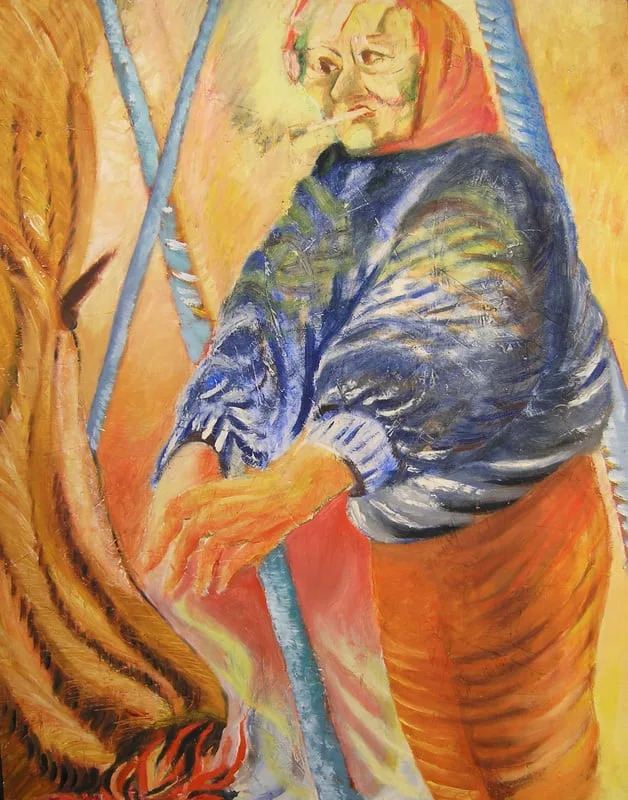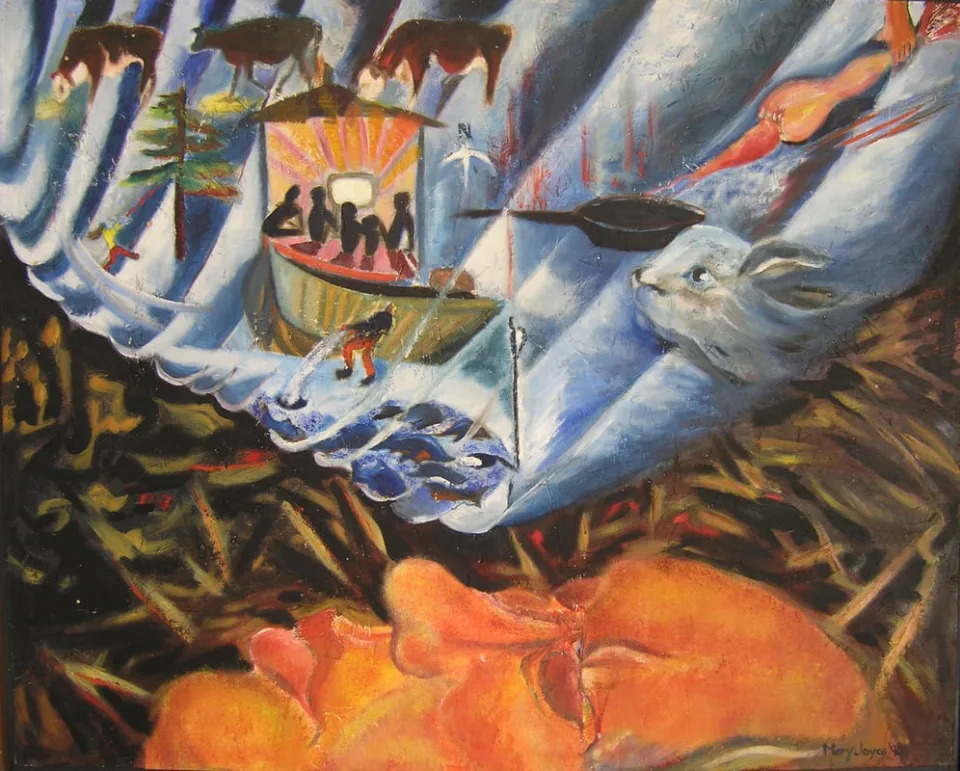CBC
Mon, October 9, 2023

Joyce painted this oil on gesso piece in 1990, called From Under the Melting Snow in Spring. It represents the spring melt after a long winter. (Submitted by Mary Joyce - image credit)
A little over 30 years ago, Mary Joyce moved to Black Point, Sask., for a year. She left the remote northern Saskatchewan hamlet with an impressive art collection and a deep appreciation for the Indigenous community's ways of life.
Now in 2023, she's giving back to the community by donating her paintings in the Black Point collection that vividly depict the people she met, the stories she heard and the lessons she learned.
Joyce and her then husband left Edmonton to start their one year stint in Black Point, near La Loche, Sask., in October of 1989. She says no white person had ever spent the full winter in the hamlet.
A lot of her paintings focus on the women's roles because Joyce says they helped integrate her into the community.
"The women were looking out for me, they basically educated me, took care of me, taught me what they were doing, and made quite a lot of jokes, along with me," Joyce said on CBC Radio's Saskatchewan Weekend.
"I learned a lot of things about how to carry on in a community like that, as well as life lessons."
Focus on traditions
Joyce hoped her paintings could spread awareness around the ways of life in Black Point.
"My paintings are mostly about the old ways, because Black Point was a kind of a community where people who still wanted to pursue the old ways, their traditions," Joyce said.

This 1990 painting titled Véronique with Hide was made with oil on gesso panel, and shows an elder in the golden light inside her teepee tending the hide as it is smoked.
This 1990 painting titled Véronique with Hide was made with oil on gesso panel, and shows an elder in the golden light inside her teepee tending the hide as it is smoked. (Submitted by Mary Joyce)
One of the experiences that stands out most for Joyce is spending time with the local woman in the smoking teepee tending to moose hide.
"Those are good memories. They were very intimate, " Joyce said.
Paintings returning home
The homecoming of the Black Point collection is being done with the help of the Mann Art Gallery in Prince Albert. The art gallery received the donation from Joyce and transported some of the paintings up to the La Loche Friendship Centre last week. The paintings will be in La Loche on rotating long-term loans.
"People came through and immediately recognized their relatives, their great aunties, their grandmothers," Marcus Miller, the Mann Art Gallery's curator and director said.
"I'm telling you, there were smiles on everybody's faces and I knew that these paintings had truly come home to the right place."
Miller says Joyce's artwork does an amazing job of depicting real life in Black Point in 1989 and 1990. Joyce wrote extensive captions to go alongside with each painting to describe who the person was in the piece and what they were doing.

Rosie’s Dream, oil on gesso panel, 24 x 30”, 1990. Joyce painted this piece of a woman dreaming to juxtapose the arrival the television in Black Point with more traditional activities such as swinging on a tree and ice fishing. This 1990 painting titled Rosie's Dream was made with oil on gesso panel. (Used with permission of Mary Joyce)
One of the paintings Miller highlighted shows an Indigenous woman named Rosie dreaming about kids watching TV — a newer addition to the community at the time. The painting also features a daughter playing on a swing and an older brother ice fishing.
Joyce says that painting is about her concern for her kids' futures.
"The reality that Mary captured here, that's what's going to do it for people. That's what did it for me," Miller said.
Starting conversations
Leonard Montgrand, executive director of the La Loche Friendship Centre, says the paintings tell an important story.
"I think it tells the story of our elders, especially in Black Point. I see a lot of our elderly people there. Some of them are probably not around today, but it creates an atmosphere of conversation," Montgrand said.
"These paintings reflect our culture and our history … we try to keep that as much as we possibly can, but our languages, our culture are very strong."

Cathy Montgrand, granddaughter of Vulgazeh — one of Mary Joyce's most important subjects, and Leonard Montgrand, centre, shake hands with Marcus Miller, right, at the La Loche Friendship Centre. (Submitted by Marcus Miller )
Joyce says she thinks the paintings belong back in the community that inspired them.
"I'm getting on in life and I want to take care of these things before I die," Joyce said.
"So to have the whole collection in the care of a respectable art gallery who will make sure that it is cared for properly, remains intact and is accessible to the people that it belongs to, morally, that really pleases me."
MARY JOYCE IS A WELL KNOWN EDMONTON ARTIST, ASST. FINE ARTS PROF, AND A PERENNIAL CANDIDATE FOR THE COMMUNIST PARTY OF CANADA (MARXIST-LENNIST) CPC-ML
No comments:
Post a Comment